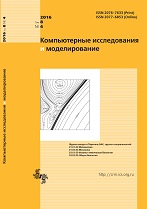|
This article is cited in 1 scientific paper (total in 1 paper)
MODELS OF ECONOMIC AND SOCIAL SYSTEMS
Mathematical modeling of the age groups of employed peoples by the example of the southern regions of the Russian Far East
M. Yu. Khavinson, M. P. Kulakov, E. Ya. Frisman
Institute for complex analysis of regional problems FEB RAS,
4 Sholom-Aleikhem St., Birobidzhan, 679016, Russia
Abstract:
The article focuses on a nonlinear mathematical model that describes the interaction of the different age groups of the employed population. The interactions are treated by analogy with population relationship (competition, discrimination, assistance, oppression, etc). Under interaction of peoples we mean the generalized social and economic mechanisms that cause related changes in the number of employees of different age groups. Three age groups of the employed population are considered. It is young specialists (15–29 years), workers with experience (30–49 years), the employees of pre-retirement and retirement age (50 and older). The estimation of model's parameters for the southern regions of the Far Eastern Federal District (FEFD) is executed by statistical data. Analysis of model scenarios allows us to conclude the observed number fluctuations of the different ages employees on the background of a stable total employed population may be a consequence of complex interactions between these groups of peoples. Computational experiments with the obtained values of the parameters allowed us to calculate the rate of decline and the aging of the working population and to determine the nature of the interaction between the age groups of employees that are not directly as reflected in the statistics. It was found that in FEFD the employed of 50 years and older are discriminated against by the young workers under 29, employed up to 29 and 30–49 years are in a partnership. It is shown in most developed regions (Primorsky and Khabarovsk Krai) there is‘uniform’ competition among different age groups of the employed population. For Primorsky Kraiwe were able to identify the mixing effect dynamics. It is a typical situation for systems in a state of structural adjustment. This effect is reflected in the fact the long cycles of employed population form with a significant decrease in migration inflows of employees 30–49 years. Besides, the change of migration is accompanied by a change of interaction type — from employment discrimination by the oldest of middle generation to discrimination by the middle of older generation. In less developed regions (Amur, Magadan and Jewish Autonomous Regions) there are lower values of migration balance of almost all age groups and discrimination by young workers up 29 years of other age groups and employment discrimination 30–49 years of the older generation.
Keywords:
mathematical model, employed population, interaction, age groups, Russian Far East.
Received: 15.09.2016
Revised: 04.10.2016
Accepted: 10.10.2016
Citation:
M. Yu. Khavinson, M. P. Kulakov, E. Ya. Frisman, “Mathematical modeling of the age groups of employed peoples by the example of the southern regions of the Russian Far East”, Computer Research and Modeling, 8:5 (2016), 787–801
Linking options:
https://www.mathnet.ru/eng/crm28 https://www.mathnet.ru/eng/crm/v8/i5/p787
|

|




 Contact us:
Contact us: Terms of Use
Terms of Use
 Registration to the website
Registration to the website Logotypes
Logotypes








 Citation in format
Citation in format 
